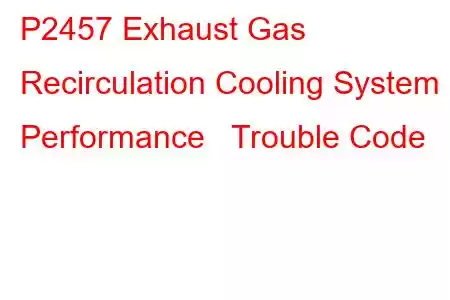P2457 Exhaust Gas Recirculation Cooling System Performance
OBD-II Trouble Code Technical Description
Exhaust Gas Recirculation Cooling System Performance
What does that mean?
This diagnostic trouble code (DTC) is a generic powertrain code, which means that it applies to all 1996-newer vehicles (Ford, Dodge, GMC, Chevrolet, Mercedes, VW, etc.). Although generic, the specific repair steps may vary depending on make/model.
Should your OBD-II equipped vehicle exhibit a P2457, it means that the powertrain control module (PCM) has detected a possible malfunction in the exhaust gas recirculation (EGR) cooling system. This may be a mechanical issue or an electrical malfunction.
The EGR system is responsible for delivering a portion of spent exhaust gases back to the intake manifold so that it can be burned a second time. This process is necessary in order to reduce the number of nitrogen oxide (NOx) particles that are released into the atmosphere. NOx is a contributing component of ozone depleting exhaust emissions.
The need for EGR cooling systems is limited (to my knowledge) to diesel engine equipped vehicles. Engine coolant is used to reduce the temperature of engine exhaust gases before they are drawn into the EGR valve. An EGR temperature sensor provides the PCM with variations in exhaust gas temperature near the EGR valve. The PCM compares input signals from the EGR temperature sensor and an auxiliary exhaust temperature sensor to determine if the EGR cooling system is operating efficiently.
The EGR cooler typically resembles a small radiator (or heater core) with fins on the outside, a coolant inlet and outlet, as well as one or more exhaust pipe/s or tube/s through the center. Air flows across the fins to reduce the temperature of both the coolant (flowing around the outer diameter of the cooler) and the exhaust (flowing through the center of the cooler).
The auxiliary exhaust temperature sensor is usually positioned in the down pipe and the EGR temperature sensor is near the EGR valve. If the EGR temperature sensor input signal is not within programmed specifications, or if the EGR sensor input signal is not significantly lower than that of the auxiliary exhaust temperature sensor, a P2457 will be stored and a malfunction indicator lamp may be illuminated.
Symptoms & Severity
Since P2457 is related to the exhaust emissions system, it is not considered an urgent code. Symptoms of a P2457 code may include:
There may be no symptoms when this code is stored Diminished fuel efficiency A stored code Malfunction indicator lamp illumination Coolant leak Exhaust leak Exhaust temperature sensor codesCauses
Potential causes for this code to set are:
Low engine coolant Defective EGR temperature sensor Faulty exhaust temperature sensor Exhaust leaks Clogged EGR cooler Engine overheatingDiagnostic and Repair Procedures
A good starting point is always to check for technical service bulletins (TSB) for your particular vehicle. Your issue may be a known issue with a known fix put out by the manufacturer and can save you time and money during diagnosis.
Some type of diagnostic scanner, a digital volt/ohmmeter, a vehicle service manual (or the equivalent), and an infrared thermometer with a laser pointer are all tools that I would use to diagnose a P2457.
I might begin with a visual inspection of the wiring harnesses and connectors associated with the EGR temperature sensor and the exhaust temperature sensor. Carefully examine harnesses that are in close proximity to hot exhaust pipes and manifolds. Load test the battery, check battery terminal ends, battery cables, and alternator output before proceeding.
I like to connect the scanner to the vehicle and retrieve all stored codes and freeze frame data at this time. Record the information because you ma
Read: 23


